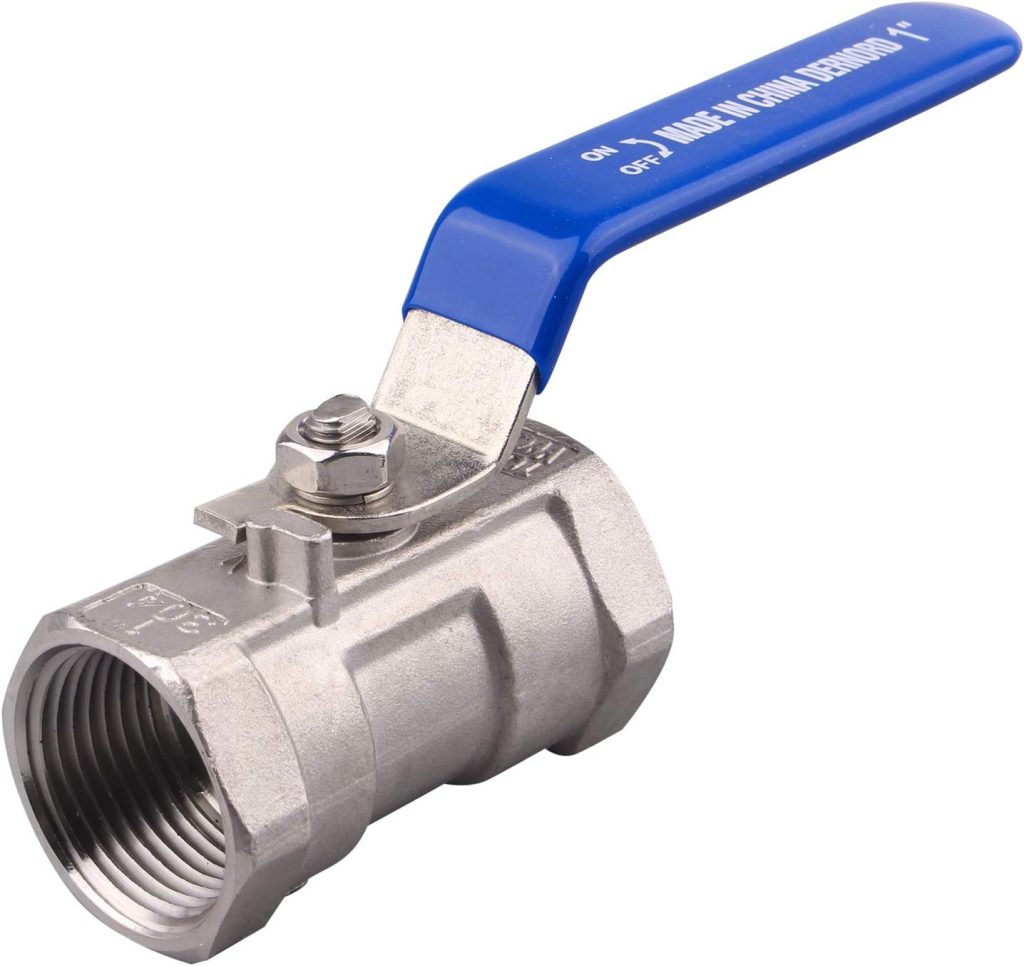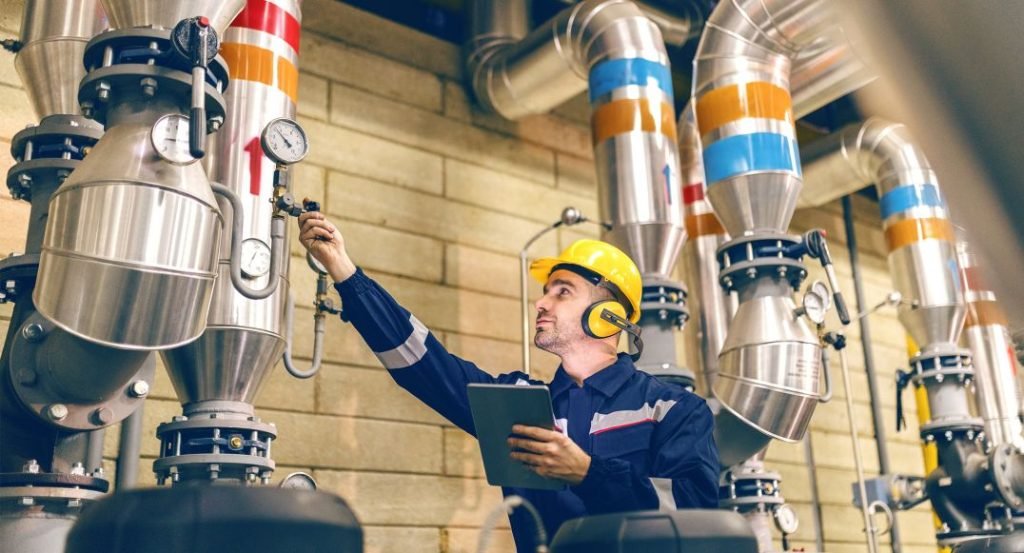

Industriearmaturen Sie sind ein wichtiger Bestandteil jedes Rohrleitungssystems und regulieren, lenken und steuern den Durchfluss von Flüssigkeiten, Gasen und Schlamm in verschiedenen Branchen. Sie kommen unter anderem in Kraftwerken, Chemieanlagen, Öl- und Gasbetrieben sowie Wasseraufbereitungsanlagen zum Einsatz. Das richtige Ventil kann die Leistung, Sicherheit und Effizienz Ihres Systems erheblich beeinflussen.
Dieser Artikel beschreibt die 10 häufigsten Arten von Industrierohren und Ventilen, erklärt ihre Funktionsweise und hilft Ihnen zu verstehen Funktionsweise von Industrieventilenund worauf Sie achten müssen, wenn Sie das beste Ventil für Ihre industrielle Anwendung auswählen.
Gegründet im Jahr 2015 und mit Hauptsitz in Zhejiang, China, PROCAMLOCK hat sich schnell zu einem vertrauenswürdigen Hersteller von Camlock-Armaturen, Ventilen, Filtern und Flüssigkeitstransfersystemen entwickelt. Wir beliefern einen globalen Kundenstamm in Schlüsselbranchen wie der Erdöl-, Chemie-, Landwirtschafts- sowie der Öl- und Gasindustrie.
Um internationale Qualitäts- und Umweltstandards zu erfüllen, entsprechen unsere Produkte vollständig den globalen Vorschriften und verfügen über Zertifizierungen.

Diese Zertifizierungen ermöglichen die nahtlose Integration unserer Produkte in europäisch Und Nordamerikanisch Industriesysteme.
A Kugelhahn ist ein Vierteldrehventil mit einfachem, aber effektivem Design. Kugelhähne verwenden eine hohle Kugel im Ventilkörper, um den Durchfluss zu unterbrechen. Die Kugel dreht sich um 90 Grad bzw. eine Vierteldrehung von offen nach geschlossen. Dadurch öffnet und schließt das Ventil schnell und zuverlässig.


A Absperrklappe Besteht aus einer runden Scheibe auf einer rotierenden Spindel. Beim Drehen des Stellantriebs dreht die Spindel die Scheibe von 0 bis 90 Grad. Bei 0 Grad blockiert die Scheibe den Durchfluss, da sie senkrecht zum Durchfluss steht. Bei 90 Grad steht sie zudem vollständig parallel zum Durchfluss und ermöglicht so einen vollständigen Durchfluss. Obwohl es sich um einfache Ventile handelt, verfügen sie über eine präzise Durchflussregelung und sind schnell bedienbar.

Rückschlagventile sind automatische Ventile, die dazu dienen, einen Rückfluss in einer Rohrleitung zu verhindern. Meist verfügen sie über ein verschiebbares Teil (Kugel, Scheibe oder Kolben), das bei gewünschter Fließrichtung geöffnet und bei umgekehrter Fließrichtung geschlossen wird.

A Absperrschieber Das Ventil ist mit einem Platten- oder Schieberrand ausgestattet, der entweder parallel oder rechtwinklig zur Strömungsrichtung verläuft. In vollständig geöffneter Stellung zieht sich der Schieber in die Ventilhaube zurück und gibt so den vollen Durchfluss frei. Das Schließen erfolgt am Schieber, wenn der Durchfluss durch das herunterfahrende Schieber blockiert wird.

Plattenschieber Sie verfügen über ein flaches, messerartiges Tor, das in den Durchfluss eingreift und diesen steuert oder stoppt. Tore sind üblicherweise 3–25 mm dick und bewegen sich senkrecht zum Durchfluss. Pneumatische Plattenschieber Verwenden Sie Druckluft (60–120 psi), um die Betriebsgeschwindigkeit zu aktivieren und zu ermöglichen.

Absperrventile Verwenden Sie einen Kugelkörper mit einem beweglichen runden Scheibenelement und einem festen Ringsitz. Die Scheibe bewegt sich im 90-Grad-Winkel zum Sitz auf und ab und ermöglicht so eine sehr präzise Durchflussregelung. Durch Drehen des Handrads bewegt der Ventilschaft die Scheibe zum Sitz hin oder von ihm weg und ermöglicht so eine präzise Durchflussregelung. Kugelhahnen bieten hervorragende Drosselleistung.

A Nadelventil ist ein Spezialventil mit einer langen, konischen, nadelartigen Scheibe. Ein Nadelventil ähnelt funktional einem Kugelhahn und gehört zur Familie der linearen Ventile, für die es eine präzise Durchflussregelung ermöglicht. Die Konstruktion ermöglicht zudem eine bessere Kontrolle bei geringem Durchfluss.

A Quetschventil Besteht aus einem flexiblen Schlauch, der sich in einem Ventilkörper befindet. Quetschventile funktionieren, indem der Schlauch mithilfe von Rollen, Stangen und/oder pneumatischen Antrieben „abgeklemmt“ wird. Beim Zudrücken des Schlauchs schließt er sich allmählich und drosselt so den Durchfluss. Sobald der Schlauch abgeklemmt und vollständig geschlossen ist, wird der Durchfluss gestoppt.

Kükenhähne Verwenden Sie einen konischen oder zylindrischen Stopfen mit einer Bohrung, die sich im Ventilkörper um die eigene Achse dreht. Nach der Installation kann das Ventil den Durchfluss anpassen, indem der Stopfen um 90 Grad gedreht wird, sodass die Bohrung mit den Ein- und Auslassöffnungen ausgerichtet oder versetzt ist.

Druckbegrenzungsventile sind ein Sicherheitsmechanismus zum Schutz vor Überdruck in Systemen. Sie bestehen aus einer federbelasteten Scheibe auf einem Sitz. Steigt der Systemdruck über die Federkraft hinaus, hebt sich die Scheibe, wodurch Flüssigkeit entweichen und den Druck entlasten kann. Sobald der Flüssigkeitsdruck unter den Sollwert fällt, setzt sich die Scheibe wieder zurück.
Ventiltypen | Kompletter Leitfaden zu Industrieventiltypen
| Ventiltyp | Design & Betrieb | Anwendungen | Wichtige Materialien | Vorteile | Einschränkungen |
| Kugelhahn | Kugelscheibe mit Bohrung, Vierteldrehbetätigung | Pipelines, Öl und Gas, Wasseraufbereitung | Edelstahl, Messing, PVC | Schnelle Bedienung, dichte Abdichtung, geringer Druckabfall | Nicht zum Drosseln geeignet |
| Absperrklappe | Scheibe dreht sich auf der Welle, Vierteldrehung | Heizungs-, Lüftungs- und Klimatechnik, Wasseraufbereitung, Rohrleitungen mit großem Durchmesser | Gusseisen, Sphäroguss, Edelstahl | Kompakte Bauweise, schnelle Bedienung, gute Drosselung | Nicht für Hochdruckanwendungen geeignet |
| Rückschlagventil | Selbsttätig, verhindert Rückfluss | Pumpensysteme, Wasserversorgung, Öl- und Gaspipelines | Edelstahl, Bronze, PVC | Automatischer Betrieb, schnelle Reaktion auf Strömungsumkehr | Eingeschränkte Kontrolle über die Durchflussraten |
| Absperrschieber | Flaches/keilförmiges Tor bewegt sich senkrecht zur Strömung | Wasserverteilung, Ölpipeline, Kraftwerke | Gusseisen, Stahl, Bronze | Hervorragende Abdichtung, geringer Druckabfall bei vollständiger Öffnung | Langsame Vorgänge, nicht zum Drosseln geeignet |
| Plattenschieber | Messerartiges Tor schneidet durch das Medium | Zellstoff und Papier, Abwasser, Bergbau | Edelstahl, Kohlenstoffstahl, Gusseisen | Optimal für Schlämme, schneller Betrieb mit pneumatischer Betätigung | Nicht für Hochdruckanwendungen geeignet, mögliche Sicherheitsrisiken |
| Absperrventil | Bewegliches Scheibenelement, präzise Durchflussregelung | Dampfsystem, Kraftwerke, chemische Verarbeitung | Bronze, Gusseisen, Edelstahl | Hervorragende Drosselung, stabile Durchflusseigenschaften | Höherer Druckabfall im Vergleich zu Absperrschiebern |
| Nadelventil | Langer, konischer, nadelartiger Kolben für präzise Kontrolle | Hydraulische/pneumatische Systeme, Instrumentierung, Probenahme | Edelstahl, Messing, exotische Legierungen | Außergewöhnliche Genauigkeit bei der Durchflussregelung, Hochdruckfähigkeit | Nicht geeignet für Anwendungen mit hohem Durchfluss |
| Quetschventil | Flexibler Schlauch zur Durchflusskontrolle eingeklemmt | Bergbau, Abwasser, Lebensmittel und Getränke | Elastomere (Kautschuk, EPDM, Viton) | Am besten für Schlämme und abrasive Medien geeignet, voller Durchfluss im geöffneten Zustand | Begrenzte Druckwerte, regelmäßiger Hülsenaustausch |
| Kükenventil | Zylindrischer/konischer Stopfen dreht sich zur Durchflussregelung | Öl und Gas, Petrochemie, Abwasserbehandlung | Gusseisen, Kohlenstoffstahl, Edelstahl | Dichter Abschluss, geringer Druckabfall bei voller Öffnung | Kann teuer sein und erfordert möglicherweise ein hohes Drehmoment für den Betrieb |
| Überdruckventil | Federbelastete Scheibe öffnet bei eingestelltem Druck | Kessel, Druckbehälter, Raffinerien | Edelstahl, Bronze, Gusseisen | Schnelle Reaktion bei Überdruck, zuverlässiger Schutz | Erfordert regelmäßige Wartung und Prüfung |
Normen für Industrieventile dienen als Richtlinien, um sicherzustellen, dass die von uns verwendeten Ventile die Qualitäts-, Sicherheits-, Leistungs- und sonstigen Anforderungen verschiedener Branchen erfüllen. Normen bestimmen alle Aspekte von Ventilen – von der Konstruktion und Materialauswahl bis hin zu Druckklassen, Abmessungen und der Art und Weise, wie Ventile geprüft werden.

Zu den gängigen Ventilstandards gehören:
Durch den Einsatz von Ventilen von ITT Industries, die den anerkannten Industrielle Ventilstandards für Sicherheit und Leistung führt in der Regel zu einer höheren Systemzuverlässigkeit und -sicherheit. Gleichzeitig gewährleistet die umfassende Auswahl ergänzender Geräte eine nahtlose Integration in die komplexen Systeme des Endbenutzers.
Richtig Wartung von Industrieventilen ist wichtig, um eine lange Lebensdauer zu erreichen, Sicherheit und zuverlässigen Betrieb zu gewährleisten und die Systemkosten niedrig zu halten. Wartungsfreundliche Industrieventile sind regelmäßig hohem Druck, korrosiven und abrasiven Substanzen sowie extremen Temperaturen ausgesetzt. Daher ist es wichtig, das Ausfallrisiko durch unsachgemäß gewartete Ventile zu berücksichtigen, um unnötige Ausfallzeiten zu vermeiden.

Empfohlene Wartungspraktiken:
1. Regelmäßige Sichtprüfung
2. Reinigung und Schmierung
3. Austausch von Dichtungen und Dichtungsringen
4. Stellgliedprüfungen
5. Dokumentation und Wartungsplan
Regelmäßige Reparaturen und Wartungen von Industrieventilen sorgen für eine verbesserte Systemleistung, erfüllen die industriellen Sicherheitsstandards und -vorschriften und fördern die Betriebszeit und Zuverlässigkeit.
Die Wahl des Besten Der Ventiltyp ist entscheidend für die Zuverlässigkeit und Effizienz des Systems. Jeder Ventiltyp hat spezifische Eigenschaften; Kugelhähne beispielsweise öffnen schnell, und Durchgangsventile ermöglichen eine präzise Steuerung. Es gibt jedoch besondere Anforderungen Ihrer Anwendung, die Sie bei Ihrer Entscheidung berücksichtigen sollten, darunter Druck, Durchflusseigenschaften und Temperatur.
Benötigen Sie Hilfe bei der Auswahl des richtigen Ventils für Ihr System? Kontaktieren Sie uns Lassen Sie sich fachkundig beraten und erkunden Sie unser Sortiment an hochwertigen Ventilen, die auf Ihre technischen Anforderungen zugeschnitten sind.
A: Ein Sicherheitsventil ist ein spezielles Ventil, das Druckbehälter, Rohrleitungssysteme und andere Geräte vor Überdruck schützt.
A: Ein Druckminderventil oder Druckregler funktioniert, indem er den Flüssigkeitsdruck von einem höheren Eingangsdruck auf einen konstanten und niedrigeren Ausgangsdruck senkt.
A: Bei der Ventiltypprüfung handelt es sich um einen Prozess zur Untersuchung des Ventiltyps, um sicherzustellen, dass dieser den erforderlichen Zuverlässigkeits-, Leistungs- und Sicherheitsstandards entspricht.
A: Durch strenge Tests der Ventilkonstruktion wird sichergestellt, dass die Ventile sicher sind, eine gute Leistung erbringen und zuverlässig sind.
